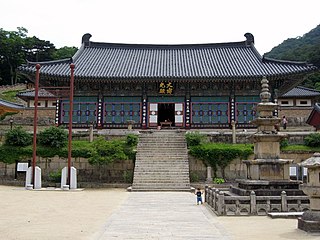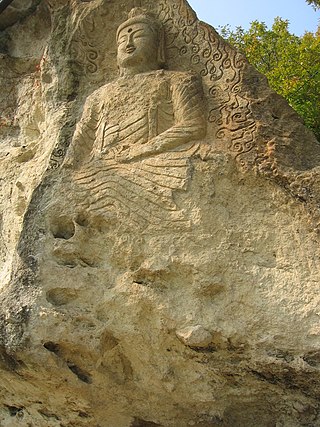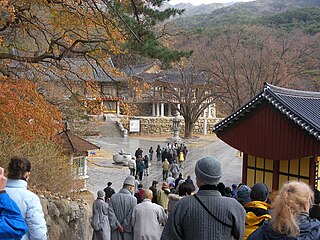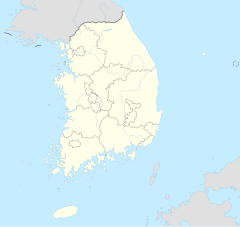
Haeinsa is a head temple of the Jogye Order of Korean Seon Buddhism in Gayasan National Park, South Gyeongsang Province, South Korea. Haeinsa is most notable for being the home of the Tripitaka Koreana, the whole of the Buddhist Scriptures carved onto 81,350 wooden printing blocks, which it has housed since 1398.

The traditional culture of Korea is the shared cultural and historical heritage of Korea before the division of Korea in 1945.
Buddhist temples are an important part of the Korean landscape. This article gives a brief overview of Korean Buddhism, then describes some of the more important temples in Korea. Most Korean temples have names ending in -sa, which means "temple" in Sino-Korean.

Bulguksa is located on the slopes of Mount Toham. It is a head temple of the Jogye Order of Korean Buddhism and encompasses six National treasures of South Korea, including the Dabotap and Seokgatap stone pagodas, Cheongun-gyo, and two gilt-bronze statues of Buddha. The temple is classified as Historic and Scenic Site No. 1 by the South Korean government. In 1995, Bulguksa was added to the UNESCO World Heritage List together with the Seokguram Grotto, which lies four kilometers to the east.

Jinan County (Jinan-gun) is a county in North Jeolla Province, South Korea.

Hamyang County (Hamyang-gun) is a county in South Gyeongsang Province, South Korea.

Golgulsa is located 20 km east of the ancient Silla Dynasty capital city of Gyeongju in Southeastern Korea. In the Golgulsa temple area can be found the oldest historical Buddhist ruins on Mt. Hamwol and the only cave temple in Korea.

Donghwasa, also Donghwa Temple, is a Buddhist temple of the Jogye Order in northern Daegu, South Korea. The temple is located on the south side of Mt. Palgongsan, within the boundaries of Dohak-dong, Dong-gu, near Daegu's northern border. The name means "Temple of Paulownia Blossoms."

Woljeongsa is a head temple of the Jogye Order of Korean Buddhism, located on the eastern slopes of Odaesan in Pyeongchang County, Gangwon Province, South Korea. Woljeongsa was founded in 643 by the Silla monk Jajang.

The National Museum of Korea is the flagship museum of Korean history and art in South Korea and is the cultural organization that represents Korea. Since its establishment in 1945, the museum has been committed to various studies and research activities in the fields of archaeology, history, and art, continuously developing a variety of exhibitions and education programs.

The Gyeongju Historic Areas of South Korea were designated as a World Heritage Site by UNESCO in 2000. The protected areas encompass the ruins of temples and palaces, outdoor pagodas and statuary, and other cultural artifacts left by the Silla Kingdom. The historic areas are sometimes known as one of the largest outdoor museums in the world.

Bunhwangsa is a temple complex from the Old Silla era of Korea. It is located in Gyeongju. The temple is recorded to have been built in 634 under the auspices of Queen Seondeok. Today the temple is still used by a small group of worshipers but in its heyday, the temple covered several acres and was one of the four main temples of the Silla Kingdom used by the state to ask the Buddha to bless the kingdom. The ruins of Hwangnyongsa Temple lay nearby. It is part of the UNESCO world heritage site Gyeongju Historic Areas.

Unjusa or Unju Temple is a Korean Buddhist temple located in Hwasun County, South Jeolla province, South Korea. It is 26 km (16 mi) southwest of Hwasun County or 40 km (24 mi) south of Gwangju. Compared with other temples in South Korea, this temple has an unusual collection of stone Buddha statues and stone pagodas, so Unjusa is often referred to as the mysterious temple. Among several assumptions regarding its origin, the most widely known one is that Monk Doseon founded the temple based on geomancy during the late period of Silla Dynasty, but the origins remain unverified.
Korean Buddhist sculpture is one of the major areas of Korean art. Buddhism, a religion originating in what is now India, was transmitted to Korea via China in the late 4th century. Buddhism introduced major changes in Korean society. The complexity of the religious sutras sent to Korea required the aristocrats who adopted the religion to become literate and required the training and importation of literate scribes. Little evidence of religious art exists in Korea before the introduction of Buddhism. Subsequent to its introduction, the religion inspired the production of devotional art as well as the beginnings of sophisticated temple architecture.

Mihwangsa is a Buddhist temple on Dalmasan, nicknamed ‘Geumgangsan of the Korean peninsula, Haenam County, South Jeolla Province, South Korea.

Geumtapsa or Geumtap Temple, a Korean Buddhist Temple, is located at the base of Cheondeungsan (mountain) in Podu-myeon (township), Goheung-gun (county), Jeollanam-do (province), South Korea. The temple is known for being a Bhikkhuni refuge and is affiliated with the Jogye Order of Korean Buddhism.

Eunsusa is a small Korean Buddhist temple that sits at the base of Sutmaibong (peak), or Elephant Rock, in the Maisan in Jinan County, North Jeolla Province, South Korea.

Tapsaand the Stone Pagodas of Mount Mai is a small Korean Buddhist Temple complex found in the Maisan in Jinan County, North Jeolla Province, South Korea.

Historic site of Seongjusa temple is no.307 South Korean historic site in Boryeong City, South Chungcheong Province built in Baekje era. According to Samguksagi, The temple was said to be built by King Beop of Baekje around 600 and played critical role as Nine mountain schools during North South States Period in Silla. but whole structures were arsoned during Japanese invasion of Korea in late 16th century. However, Stele accompanying pagoda of Buddhist priest Nanghyehwasang still remains including pieces of Buddhist statue of Baekje and several roof tiles in the era of Unified Silla. The stele is registered as the national treasure of South Korea in the present time. The pagoda cherished the most fabulous architectural style with magnificent scale during Unified Silla.























